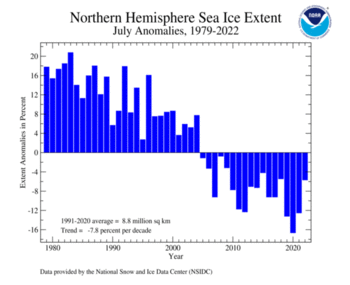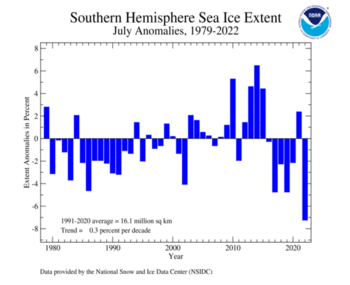Sea Ice Extent
The sea ice extent data for the Arctic and Antarctic are provided by the National Snow and Ice Data Center (NSIDC) and are measured from passive microwave instruments onboard NOAA Satellites. The sea ice extent period of record is from 1979–2022 for a total of 44 years.
| July 2022 | Sea Ice Extent | Anomaly 1991-2020 | Trend per decade | Rank (44 years) | Record | ||||
|---|---|---|---|---|---|---|---|---|---|
| million km² | million mi² | Year(s) | million km² | million mi² | |||||
| Northern Hemisphere | 8.29 | 3.20 | -5.26% | -7.66% | Largest | 32nd | 1983 | 10.57 | 4.08 |
| Smallest | 13th | 2020 | 7.29 | 2.81 | |||||
| Southern Hemisphere | 14.99 | 5.79 | -6.72% | +0.31% | Largest | 44th | 2014 | 17.11 | 6.61 |
| Smallest | 1st | 2022 | 14.99 | 5.79 | |||||
| Globe | 23.28 | 8.99 | -6.20% | -2.46% | Largest | 41st | 1979 | 26.83 | 10.36 |
| Smallest | 4th | 2019 | 22.89 | 8.84 | |||||
Data Source: National Snow and Ice Data Center (NSIDC). Period of record: 1979–2022 (44 years)
Globally, July 2022 saw the third-lowest July sea ice extent on record. Only the Julys of 2019 and 2020 had a smaller sea ice extent.
The Arctic sea ice extent for July 2022 was 8.25 million square km (3.19 million square miles), which is about 1.22 million square kilometers (471,000 square miles) — roughly the size of South Africa — below the 1981–2010 average. Overall, July 2022 was the 12th-smallest Arctic sea ice extent on record for July. Sea ice extent was well below average in the Barents, Kara, and Greenland seas, the Sea of Okhotsk, and the Hudson Bay. Baffin Bay and the Chukchi and Eastern Siberian seas had near-normal or slightly-below average sea ice extent for the month. The Bering and Beaufort seas had above-average sea ice extent for July.
For the second consecutive month, Antarctica set a record low sea ice extent since records began in 1979. The July 2022 Antarctic sea ice extent was 14.90 million square km (5.75 million square miles), or 1.06 million square km (409,000 square miles) below average. According to NSIDC, the Weddell and Bellingshausen seas and the East Antarctic coast experienced low sea ice extent for the month, and recent low ice extents in the region are largely attributable to large-scale circulation patterns including the Amundsen Sea Low, which typically pushes warm air from the northwest into the northern Weddell Sea.
 NOAA's National Centers for Environmental Information
NOAA's National Centers for Environmental Information

